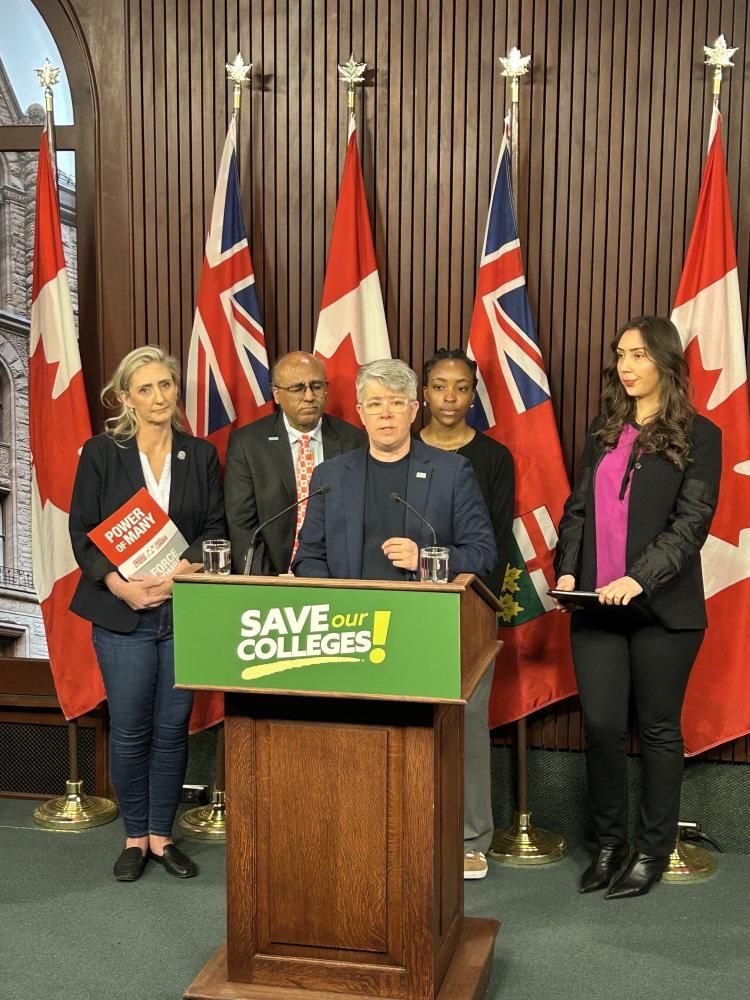As Canada braces for the economic fallout of dramatic tariffs announced by Donald Trump, labour, student, and post-secondary advocacy leaders gathered at Queen's Park on the first day of legislature returning with a simple message: how well Ontario weathers the storm depends on reversing course on the crisis facing its college system. Without significant ministerial intervention - including raising baseline funding - Ontarians could be left unsheltered.

Student, labour, and post-secondary leaders gather in a joint brief on the college crisis. From left to right: Laura Walton, OFL President, Nigmendra Narain, OCUFA President.
"Historically, college enrollment rises with unemployment and during recessions," said JP Hornick, President of OPSEU/SEFPO, the union representing college workers. "The political tide is bringing in a restructuring of our economy. As we chart that landscape, we'll need expanded access to local post-secondary education to transition between jobs or industries."
"Instead, what we're seeing are cuts to streams with core social and economic functions. We're talking paramedic programs, engineering programs, child and youth care programs - it's like taking a sledgehammer to the walls of this province, and hoping the roof doesn't come down," added Hornick.
As of April 2025, 21 out of 24 public colleges have announced some combination of program closures, intake suspensions, and job losses.
"In this time of economic uncertainty, Doug Ford must diversify investments across all pathways to education - so Ontarians can train for good jobs in every sector of the economy," said Laura Walton, OFL President. "Strong community colleges are good for workers looking to upskill, for industries seeking skilled workers, and as economic drivers for many Ontario communities."
Adaeze Mbalaja, Chairperson for the Canadian Federation of Students - Ontario (CFS-O), noted that college cuts restrict access to post-secondary education on more than one front.
"The removal of college to university pathways, free community college programs and the talk of campus closures of small, rural and Northern institutions are all symptoms of the chronic underfunding of post-secondary education," said Mbalaja. "The recent program closures at colleges and universities highlight the government's undervaluing of education. Students need publicly funded, free, and locally accessible education."
"'There is no more important commitment that a government can make than to education' - that's a direct quote from former Ontario PC Premier Bill Davis, whose legislature founded our college system," said Nigmendra Narain, President of OCUFA. "Back then, government funding reflected this principle, covering as much as three-quarters of operating costs in the post-secondary sector. Ontarians weren't expected to personally carry the weight of funding public education, as government understood investing in post-secondary education was investing in a bright and prosperous future for all Ontarians."
Today, tuition fees account for 68 per cent of the college system's revenues - and provincial grants are only declining. Ontario consistently ranks dead-last for per-student funding, at 56 per cent of the national average. Back in February, advocates argued that underfunding of the system led to unstable and exploitative paths to financial stability, including a reliance on international student tuition.
Ontario colleges have long-profited off that now-by-gone era of boundless, deregulated international tuition - and it's clear who stood to gain the most, as last week's inquiry into climbing college executive pay suggests.
But recent policy research by OPSEU/SEFPO projects that rather than plunging to international student levels not seen in a decade, the likely result of recent federal reforms is that international enrollment will return to roughly 2021 levels. The research also looks at how colleges have spent their financial reserves - with money predominantly going to capital assets and new builds.
"The crisis, then, is less so one of pocketbooks, and more so one of mismanagement - by the province and by the colleges themselves," said Hornick. "We have an opportunity to course-correct: fund the system, end profiteering, and expand access to post-secondary education instead of curtailing it."
"The future is something that we make, and we can just as easily make it into something better. If we get this right, our college system can be the lifeboat that helps us get there in the hard days ahead."

Student, labour, and post-secondary advocacy leaders gather in a joint brief on the college crisis. From left to right: Laura Walton, OFL President, Nigmendra Narain, OCUFA President; Adaeze Mbalaja, CFS-O Chairperson; Rachelle Taheri, OPSEU/SEFPO researcher; JP Hornick, OPSEU/SEFPO President.
Additional resources:
- A Better Plan - Solutions to the Crisis in Ontario's Colleges (OPSEU/SEFPO policy paper)
Quick Facts:
- Since 2018, an average of 140,000 students have graduated from Ontario's colleges each year. An average of 83 per cent of Ontario college graduates find employment within six months of graduation.
- 35 per cent of Ontarians aged 25 to 65 have a college, CEGEP or other non-university certificate or diploma, outpacing the rest-of-Canada average of 31 per cent.
- The number of university graduates applying to college has increased by 40 per cent over the past five years.
- Compared to university students, college students in Ontario are more likely to come from lower-income families, belong to racialized groups, be immigrants to Canada, or live in rural areas.
- When first established in 1965, approximately three-quarters of colleges' operating funding came from provincial government grants.
- Today, tuition accounts for 68 per cent of the colleges' operating budgets.
- While significantly larger provincial grants in the other provinces have remained relatively stable since 2010, the value of provincial grants to the colleges in Ontario, after adjusting for inflation, fell by 29 per cent from 2010-2011 to 2022-23.
- While tuition fee revenues have risen across Canada, since 2010 they have increased by 43% in the other provinces, on average - versus a staggering 200% in Ontario.
- In 2011-12, domestic tuition fees provided 78 per cent of total college fee revenues. In 2022-23, that figure dropped to 23 per cent.









